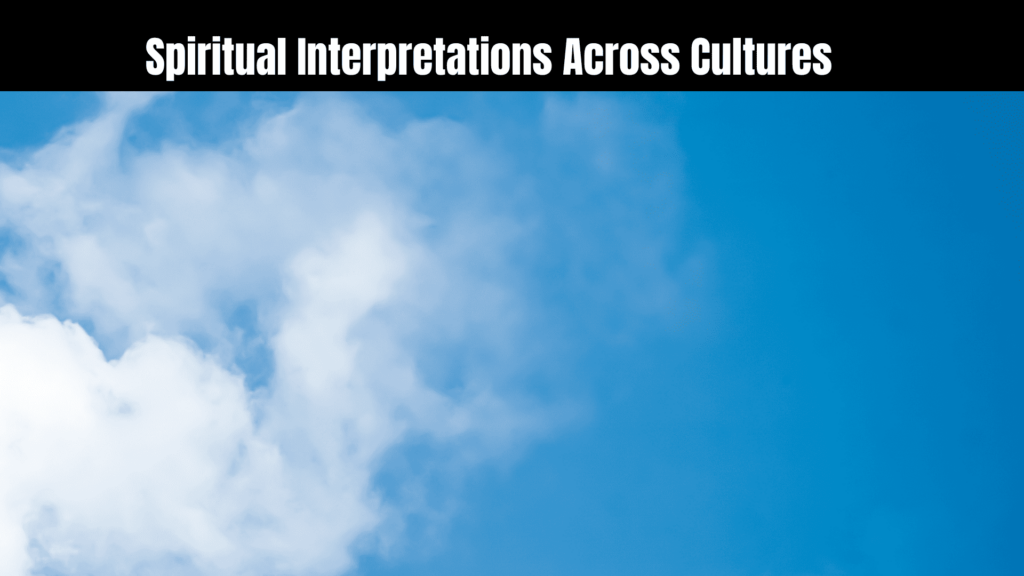Unlocking the Spiritual Meaning of a Sky
The sky has long captivated the human imagination, symbolizing boundless freedom, divine realms, and the infinite possibilities of life. Its vastness and beauty inspire awe and contemplation, making it a universal spiritual metaphor across cultures and philosophies. By examining the spiritual meaning of a sky, we uncover profound connections between nature, the divine, and our inner selves.
The Sky as a Universal Symbol

The Universal Appeal of the Sky
The sky, with its infinite expanse and ethereal beauty, has always been a source of inspiration and mystery for humanity. Stretching beyond the limits of perception, it connects people across cultures and eras, serving as a reminder of the vastness of existence and the mysteries of life. The sky’s role as a universal symbol stems from its ability to evoke emotions of awe, wonder, and spirituality.
Spiritual Connections to the Sky
A Gateway to the Divine
In spiritual contexts, the sky is often seen as a bridge between the earthly realm and the divine. Its vastness represents infinity, while its ever-changing nature reflects the dynamics of life and the universe.
- Christianity: The sky symbolizes heaven, the abode of God, and eternal peace.
- Hinduism and Buddhism: It represents freedom from material attachments and the infinite possibilities of spiritual awakening.
- Native American Traditions: The sky is viewed as the home of spirits and gods, offering guidance and protection.
The Sky in Mythology
Many mythologies draw connections between the sky and celestial beings:
- Zeus in Greek mythology was the god of the sky, wielding thunderbolts as his weapon.
- Nut, the Egyptian goddess of the sky, represented the overarching dome that protected the Earth.
- In Norse mythology, the sky was connected to Yggdrasil, the great tree that linked all realms.
The Sky as a Source of Inspiration
In Art and Literature
Artists and writers have long used the sky as a metaphor for emotions, ideals, and aspirations.
- Romantic poets like Wordsworth and Keats found the sky an emblem of beauty and the sublime.
- Painters such as Van Gogh captured its swirling patterns to reflect emotional turbulence.
Symbol of Freedom
The endless horizon of the sky symbolizes liberation. It reminds us of boundless opportunities and the ability to rise above limitations.
The Sky in Science and Exploration
A Scientific Perspective
Scientifically, the sky serves as humanity’s window into the cosmos. From the study of constellations to the exploration of distant galaxies, the sky has been central to expanding human knowledge.
- Astronomy has revealed the secrets of stars, planets, and black holes.
- The invention of the telescope turned the night sky into a map of discovery.
The Age of Space Exploration
The sky was once seen as unreachable. Today, it serves as the gateway to space. Achievements like the Moon landing and Mars rovers remind us of humanity’s potential.
Spiritual Interpretations Across Cultures

The concept of spirituality is universal, yet its interpretations vary widely across cultures. Rooted in traditions, beliefs, and experiences, spirituality shapes how communities connect with the divine, nature, and each other. Here, we explore how diverse cultures perceive spirituality and its profound impact on their lives.
Spirituality in Indigenous Cultures
Indigenous traditions worldwide often intertwine spirituality with nature. These beliefs are deeply rooted in the cycles of the Earth, the cosmos, and the interconnectedness of all life.
- Native American Spirituality: Native American tribes view nature as sacred. The Great Spirit, or Wakan Tanka, is central to their beliefs, representing a divine force that permeates everything. Rituals, dances, and ceremonies honor this connection.
- Aboriginal Australians: The Dreamtime, or Dreaming, is a spiritual framework that explains the origins of the world and guides moral and ethical living. Sacred sites, such as Uluru, are seen as physical manifestations of their ancestral spirits.
- African Traditions: In many African cultures, spirituality revolves around ancestral worship and animism. Spirits are believed to reside in natural elements, such as rivers, mountains, and trees.
Eastern Spiritual Traditions
Eastern cultures emphasize inner peace, balance, and the pursuit of enlightenment. These philosophies often prioritize self-realization over external worship.
- Hinduism: At the heart of Hindu spirituality is the concept of Brahman, the ultimate reality. Practices like meditation and yoga aim to align the individual soul (Atman) with this universal truth.
- Buddhism: Founded by Siddhartha Gautama, Buddhism teaches the path to enlightenment through the Four Noble Truths and the Eightfold Path. It emphasizes mindfulness, compassion, and the impermanence of life.
- Taoism: Originating in China, Taoism focuses on living in harmony with the Tao, or “the Way,” which is the natural order of the universe. Balance, simplicity, and humility are key values.
Spiritual Beliefs in the Middle East
The Middle East, as the birthplace of major monotheistic religions, presents spirituality as a relationship with one supreme deity.
- Judaism: Central to Jewish spirituality is the covenant between God and humanity. Prayer, the Torah, and traditions like Shabbat foster a connection to the divine.
- Christianity: Christian spirituality revolves around the life and teachings of Jesus Christ. Concepts such as grace, love, and salvation form the foundation of faith and worship.
- Islam: Muslims believe in complete submission to Allah, as outlined in the Quran. Spiritual practices include daily prayers (Salah), fasting (Sawm), and acts of charity (Zakat).
Spirituality in Asian Cultures
Asian spirituality often reflects a blend of religion, philosophy, and culture, offering diverse perspectives on the purpose of life and the afterlife.
- Confucianism: While not strictly spiritual, Confucianism emphasizes moral conduct, family harmony, and respect for ancestors as paths to a fulfilling life.
- Shinto: Indigenous to Japan, Shinto focuses on the worship of kami, or spirits. Rituals and festivals honor these divine forces, which are believed to inhabit natural phenomena and ancestors.
- Zen Buddhism: Zen emphasizes simplicity and direct experience of enlightenment. Practices like zazen (seated meditation) seek to transcend logical thought and achieve a deeper understanding of existence.
Modern Spiritual Movements
In the modern world, spirituality has evolved to include personal growth, mindfulness, and holistic wellness. These movements often draw inspiration from ancient traditions while adapting to contemporary life.
- New Age Spirituality: This movement incorporates elements of astrology, crystal healing, and meditation. It promotes personal empowerment and connection with the universe.
- Mindfulness Practices: Rooted in Buddhist traditions, mindfulness emphasizes living in the present moment. It is widely adopted in stress reduction, therapy, and corporate environments.
- Ecospirituality: This modern interpretation connects spirituality with environmentalism, emphasizing the sacredness of nature and the need to protect it.
Similarities and Differences
While spiritual interpretations vary, certain universal themes emerge across cultures:
Similarities:
- A connection to the divine, whether monotheistic, polytheistic, or pantheistic.
- Reverence for nature as a source of life and spiritual energy.
- Rituals and practices to honor ancestors or deities.
Differences:
- Some cultures focus on communal worship, while others prioritize individual enlightenment.
- Concepts of the afterlife range from reincarnation to eternal paradise.
- Symbols, rituals, and sacred texts differ based on regional and historical contexts.
The Sky and the Divine

Throughout human history, the sky has been a powerful symbol of the divine. Its vastness, beauty, and mystery evoke a profound sense of connection to forces beyond the tangible. Whether through mythology, religion, or personal reflection, the sky is often seen as a bridge between the earthly and the sacred. This article explores the deep spiritual associations between the sky and the divine across cultures, traditions, and beliefs.
The Sky as a Metaphor for Divinity
The sky’s infinite expanse serves as a natural metaphor for the divine, embodying qualities like omnipresence, mystery, and eternity. Its boundless nature mirrors humanity’s quest to understand the infinite and the unknowable.
- Omnipresence: The sky stretches across the entire Earth, visible to everyone regardless of location, symbolizing the all-encompassing nature of the divine.
- Eternity: The sky appears unchanged over millennia, a timeless backdrop that reminds us of the enduring presence of spiritual forces.
- Mystery: The vastness of the sky, with its stars, clouds, and celestial phenomena, inspires awe and curiosity, much like the divine.
The Sky in Mythology and Religion
Many cultures have looked to the sky to understand the divine, incorporating its elements into their mythologies and religious systems.
Sky Deities
- Greek Mythology: Zeus, the king of gods, was the ruler of the sky and wielder of thunder and lightning, symbolizing power and authority.
- Egyptian Mythology: Nut, the goddess of the sky, was believed to swallow the sun at night and birth it each morning, representing renewal and cosmic order.
- Hinduism: The god Indra is associated with the sky, thunder, and rain, representing strength and fertility.
The Heavens as the Abode of the Divine
In many monotheistic religions, the heavens are viewed as the dwelling place of God or the gods:
- Christianity: Heaven is described as the eternal home of God, angels, and the righteous, symbolizing purity and divine perfection.
- Islam: The Quran speaks of seven heavens, each a layer of the cosmos, with Allah reigning above all.
- Judaism: The heavens are frequently mentioned in the Torah as a realm of divine authority and blessing.
Celestial Phenomena and Spiritual Significance
Natural occurrences in the sky have long been interpreted as messages or signs from the divine.
- Rainbows: In Christianity, the rainbow is a sign of God’s covenant with Noah, symbolizing hope and divine promise.
- Solar and Lunar Eclipses: In ancient cultures, eclipses were often seen as omens, interpreted as the gods showing their displeasure or as significant cosmic events.
- Stars and Constellations: Many indigenous cultures see stars as ancestors or divine beings guiding humanity. The North Star, for example, is often seen as a symbol of guidance and constancy.
The Sky in Prayer and Worship
The act of looking up to the sky is deeply symbolic in spiritual practices. It reflects the human desire to connect with higher powers and seek guidance.
- Prayer: Many cultures encourage believers to direct their prayers toward the heavens, symbolizing communication with the divine.
- Rituals: Ancient civilizations often built temples and altars aligned with celestial events, such as solstices and equinoxes, to honor the sky’s spiritual significance.
Philosophical Interpretations of the Sky and the Divine
Philosophers and spiritual thinkers have often used the sky as a tool to explore existential questions.
- The Sublime: Philosophers like Immanuel Kant viewed the vastness of the sky as a reminder of the limits of human understanding and the presence of something greater.
- Unity: Mystics often interpret the sky’s boundlessness as a metaphor for the interconnectedness of all existence.
Modern Spirituality and the Sky
In contemporary spirituality, the sky continues to serve as a source of inspiration and reflection.
- Mindfulness Practices: Watching the sky is often used in mindfulness exercises to cultivate a sense of calm and presence.
- Ecospirituality: The sky’s beauty, especially during sunsets and starry nights, inspires many to see nature as sacred and deserving of care.
Colors of the Sky and Their Spiritual Significance

The sky’s ever-changing colors captivate the human spirit, offering moments of awe and wonder. Beyond their aesthetic beauty, these colors hold profound spiritual meanings across cultures, traditions, and philosophies. Each hue evokes unique emotions, symbolisms, and messages that connect us to the divine, nature, and our inner selves.
The Spiritual Connection to Sky Colors
Colors have been used throughout history to convey spiritual ideas and feelings. The colors of the sky, shaped by natural phenomena such as sunrise, sunset, storms, and clear days, are often seen as direct communication from the universe or divine entities.
1. Blue Sky: Clarity and Calm
A clear blue sky is universally associated with peace, tranquility, and clarity. Its spiritual interpretations include:
- Connection to the Divine: Blue is often linked to the heavens and represents the infinite nature of the divine.
- Healing and Serenity: The color promotes inner calm, reducing stress and encouraging a sense of well-being.
- Truth and Communication: Blue is also a symbol of truth and honesty, fostering open dialogue with oneself and others.
2. Golden and Orange Skies: Inspiration and Renewal
Sunrise and sunset bathe the sky in warm tones of gold and orange, which hold significant spiritual meanings:
- New Beginnings: The sunrise symbolizes renewal, hope, and the start of a new journey.
- Gratitude: The golden hues at sunset evoke a sense of gratitude and reflection on the day’s experiences.
- Creativity and Passion: Orange is a vibrant color that inspires creativity and awakens a zest for life.
3. Pink Sky: Love and Compassion
A pink sky, often seen during dawn or dusk, carries gentle and nurturing energy. Its spiritual connotations include:
- Unconditional Love: Pink represents love, kindness, and compassion, reminding us of the importance of nurturing relationships.
- Inner Peace: The soft tones encourage self-acceptance and emotional healing.
- Divine Feminine Energy: Pink is also associated with the divine feminine, symbolizing grace, intuition, and emotional depth.
4. Red Sky: Power and Warnings
A red sky, especially during sunrise or sunset, can feel both powerful and ominous:
- Vitality and Passion: Red is the color of life force, symbolizing energy, passion, and strength.
- Warnings and Protection: A red sky at night or morning often serves as a natural warning of changing weather, which many interpret as the divine urging preparation or caution.
- Transformation: Red is also a symbol of profound change and transformation, urging us to embrace challenges with courage.
5. Purple Sky: Mystery and Spiritual Awakening
A purple sky, often seen during twilight or storms, carries an air of mystery and spiritual depth:
- Spiritual Awakening: Purple is associated with the crown chakra, representing higher consciousness and enlightenment.
- Mysticism: Its rich, otherworldly hue connects us to the unknown and invites contemplation of life’s mysteries.
- Transformation: Purple skies encourage growth and self-discovery, signaling periods of personal or spiritual change.
6. Gray and Overcast Skies: Reflection and Renewal
While gray skies might seem dull, they hold unique spiritual meanings:
- Introspection: Gray invites us to look inward, encouraging moments of self-reflection and understanding.
- Pause and Renewal: Overcast skies suggest a period of rest and rejuvenation before a new phase begins.
- Subtle Guidance: The muted tones of gray can symbolize understated guidance from the universe.
7. Black Sky: Mystery and Infinite Potential
The night sky, with its dark expanse and twinkling stars, represents a world of mystery and infinite possibilities:
- The Unknown: Black symbolizes the mysteries of life and the divine, urging us to embrace the unknown.
- Potential: The darkness of the sky reminds us that creation begins in the void, representing infinite potential and new opportunities.
- Protection: In some cultures, the black sky is seen as a shield, offering protection and fostering a sense of safety during rest.
8. Rainbow Skies: Hope and Divine Promises
A rainbow in the sky, often following a storm, is rich with spiritual significance:
- Divine Covenant: In Christianity, the rainbow symbolizes God’s promise to humanity.
- Unity and Diversity: The rainbow’s many colors represent harmony and the beauty of diversity.
- Renewal and Hope: Rainbows serve as a reminder of hope and positive outcomes after challenges.
Spiritual Practices Inspired by Sky Colors
The spiritual meanings of sky colors inspire various practices aimed at connecting with the divine and enhancing personal well-being:
Sky Gazing for Meditation
Observing the colors of the sky during sunrise, sunset, or twilight can serve as a powerful meditative practice. The act of focusing on the hues helps quiet the mind and foster a sense of connection with nature.
Color Therapy
Using the colors of the sky in daily life—for example, wearing clothing or decorating spaces in blue or pink—can help align emotions and energy with spiritual goals.
Chakra Alignment
The colors of the sky are often linked to chakras:
- Blue for the throat chakra (communication).
- Purple for the crown chakra (spiritual connection).
- Red for the root chakra (grounding and vitality).
The Sky and Human Emotions

The sky, with its vast expanse and dynamic transformations, has long been a mirror to human emotions. Its colors, patterns, and moods often evoke powerful feelings, shaping how we perceive and express ourselves. Across cultures and ages, the sky serves as a profound metaphor for emotional experiences, from joy and hope to melancholy and introspection.
The Connection Between the Sky and Emotions
The interplay between the sky and human emotions stems from its ability to reflect our inner world. A stormy sky can resonate with turmoil, while a clear, blue sky might bring a sense of peace. By observing the sky, people often find comfort, inspiration, or validation of their emotional states.
1. Clear Blue Skies: Serenity and Optimism
- Symbolism: A clear blue sky is universally associated with calmness, happiness, and clarity of thought.
- Emotional Impact: It often evokes feelings of optimism, encouraging a positive outlook and emotional balance.
- Cultural Reference: In many languages, phrases like “blue skies ahead” signify hope and better days.
2. Sunrise: Renewal and Joy
- Symbolism: The rising sun brings with it the promise of a new beginning.
- Emotional Impact: The warm hues of dawn inspire hope, gratitude, and a sense of rejuvenation.
- Human Connection: The gradual transition from darkness to light mirrors the emotional journey of overcoming challenges.
3. Sunset: Reflection and Peace
- Symbolism: Sunsets signify closure, rest, and the beauty of endings.
- Emotional Impact: The vibrant colors of a sunset encourage introspection, nostalgia, and sometimes a bittersweet feeling.
- Universal Appeal: Watching a sunset is often a shared moment of awe and connection, bringing people together emotionally.
4. Stormy Skies: Turmoil and Resilience
- Symbolism: Dark, storm-filled skies represent chaos, struggle, or emotional intensity.
- Emotional Impact: While they may feel heavy or unsettling, stormy skies also symbolize resilience and the inevitability of calm after the storm.
- Artistic Influence: Stormy skies have inspired countless works of art, music, and literature, often representing inner conflict.
5. Overcast Skies: Introspection and Melancholy
- Symbolism: A gray, overcast sky suggests subdued emotions or a period of reflection.
- Emotional Impact: While it can evoke melancholy or sadness, it also encourages introspection and mental rest.
- Cultural Notes: In some traditions, overcast weather is seen as a time for contemplation or quiet creativity.
6. Rainbow Skies: Hope and Joy
- Symbolism: Rainbows symbolize hope, renewal, and the beauty that follows adversity.
- Emotional Impact: Seeing a rainbow often brings a sudden burst of happiness, surprise, and inspiration.
- Metaphorical Meaning: A rainbow is a reminder that difficulties often lead to beauty and growth.
7. Starry Nights: Wonder and Mystery
- Symbolism: A clear, star-filled night represents infinity, dreams, and the mystery of existence.
- Emotional Impact: Gazing at the stars fosters feelings of wonder, humility, and curiosity.
- Human Connection: Night skies often encourage deep conversations and contemplation of life’s purpose.
8. Changing Clouds: Fluidity and Transition
- Symbolism: Clouds are dynamic and ever-changing, symbolizing the transient nature of emotions.
- Emotional Impact: Watching clouds drift can soothe anxiety, while storm clouds can amplify feelings of tension.
- Creative Inspiration: Cloud patterns often evoke imagination and encourage artistic expression.
The Sky in Human Expression
The sky frequently appears in poetry, music, and art as a metaphor for emotional states:
- “Clouded Judgment”: Reflects confusion or uncertainty.
- “Sky’s the Limit”: Represents ambition and boundless possibilities.
- “Under a Dark Cloud”: Suggests feelings of sadness or trouble.
Emotional Practices Inspired by the Sky
1. Sky Gazing for Emotional Healing
Taking time to observe the sky can be a grounding and therapeutic activity. Whether focusing on its vastness or watching a sunset, sky gazing can help calm the mind and soothe emotions.
2. Journaling Emotions with Sky Metaphors
Using the sky as a metaphor in journaling can help articulate complex emotions. For instance, describing feelings as “stormy” or “serene” can bring clarity and self-awareness.
3. Creative Expression Through the Sky
Artists, writers, and musicians often use the sky as a central theme to explore and express their emotional landscapes.
Frequently Asked Questions (FAQs)
1. What does the sky symbolize in spirituality?
The sky symbolizes freedom, infinity, and divine connection, reflecting the boundless nature of the human spirit.
2. How can sky meditation enhance spirituality?
Sky meditation fosters mindfulness, aligns energy, and deepens our connection to the universe.
3. What is the spiritual meaning of a rainbow?
Rainbows symbolize hope, renewal, and divine promises, reminding us of beauty after adversity.
4. Why is the sky associated with the divine?
The sky is often seen as a realm of gods and spirits, bridging the earthly and celestial worlds.
5. How do colors of the sky affect emotions?
Each sky color evokes different emotions, from the calm of blue skies to the inspiration of sunsets.
6. What role does the sky play in astrology?
Astrology uses the sky to interpret celestial influences on human destiny and personality.
Conclusion
The spiritual meaning of a sky is a testament to humanity’s deep connection with nature and the cosmos. By observing and meditating on the sky, we unlock insights into our emotions, purpose, and place in the universe.